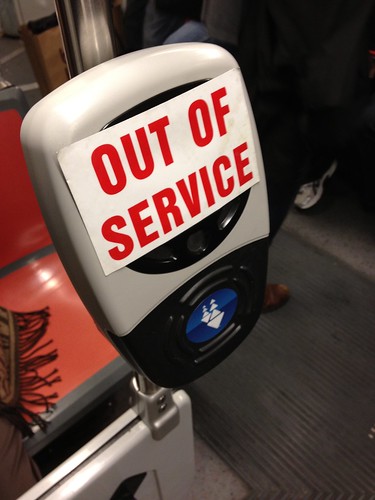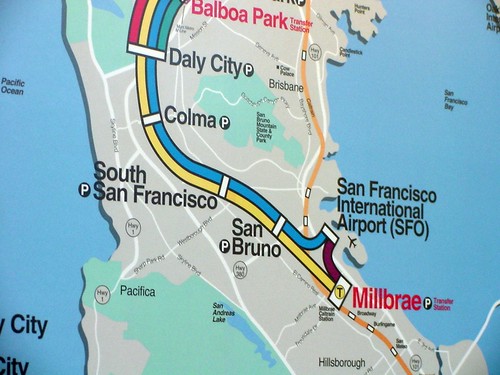 | |
| Photo from SFMTA The official sign on all rear doors |
It's now official. Hours ago, the SFMTA announced starting Sunday, July 1, 2012 all passengers can board ANY door of ALL Muni vehicles and lines.
Statistically, Muni will be the first agency in the nation to implement all-door boarding for its entire fleet and routes. The goal is to speed up the boarding process so buses can keep moving on our streets. Muni will have to invest an extra $900K in salary and benefits to hire ten more fare inspectors. The extra cost will be offset by an estimated $200K in tickets written to violators and other cost savings.
How all-door boarding works:
This is exactly like the Proof of Payment system already in place on the Muni metro and the rear door boarding procedures remains the same for the rest of the Muni fleet. This has been unofficially and illegally done on non-metro lines such as the lines going through Chinatown for many years, but has proven itself to board buses faster than through the traditional method of front door only.
Passengers with a Clipper card, metro ticket (Limited Use Ticket/LUT), paper transfer, paper pass, visitor Muni Passport, and other pre-paid Muni media can board any door. Those using a Clipper card or LUT must tag their card at the card reader inside the vehicle. Those non-Clipper media can simply board and take a seat.
Passengers paying with cash, youth fare coupon books, and those needing the wheelchair lift or bus kneeling feature must board the front door of the bus. Cash fares to the farebox, Clipper cards uses the reader, and youth coupons handed to the driver.
Pesky rules to remember:
- All Muni lines are now using the honor system known as "Proof of Payment." You must have a valid pass or fare receipt at all times. Expired passes and fare receipts/transfers are invalid and a violation of city law. It is necessary to have unexpired media at hand at all times. Passengers are subject to inspection by an officer of the peace or transit fare inspector.
- Anyone using a Clipper card or a Muni metro Limited Use Ticket (LUT) must ALWAYS tag their card/ticket on a Clipper card reader, regardless if you have a valid monthly pass or know your electronic transfer has not yet expired. If you have a current monthly pass and didn't tag it, the fare inspector will have to hassle with you and check the data on your card using their handheld reader, and that's a waste of time. For more information on why it is important to tag your card, click here.
 Respect and Courtesy
Respect and CourtesyThis is a very important topic for all-door boarding. If you are used to the unwritten "commuter rules" for BART, you know the basics for the upcoming July 1st implementation of Muni's all-door boarding.
Rule #1: Always let passengers exit the vehicle first. It's a matter of courtesy to let exiting passengers leave the vehicle first, then boarding passengers enter second. Also, exiting passengers should always be ready to exit the vehicle, don't do it late; if it's crowded, be vocal and say you need to exit the bus just BEFORE it arrives at the stop.
Rule #2: Don't clothesline passengers. If you have a Clipper card, try your best to board the correct side of the rear door that is closest to the Clipper card reader. If you board the wrong side, don't stick your arm out to tag your Clipper card on the opposite side, you could hurt someone; just wait until everyone else boarded, then tag your card.
Rule #3: If you are the only passenger at the stop, just board the front door. It's a waste of time and annoying to a bus driver and fellow passengers if you are the only person at a bus stop and you want to board the rear. Just use the front door. This makes even more practical sense for the less used Muni lines such as the community service routes. Exception: Muni metro lines, just press the door open button.
Rule #4: Respect the fare inspectors. Have your fare media available for inspection in an easy to access place. Don't crinkle your transfer up and toss it in your pocket. If you have a Clipper card, I suggest using a clear plastic protective sleeve instead of digging in your pocket for your wallet.
Rule #5: Always properly tag your Clipper card. Getting the dreaded "three beeps of death" is not just annoying to hear, but also holds up other passengers behind you trying to board and tag their card. Never swipe the card like a credit card, don't move the card around the sensor, or quickly tap the card and move the card away from the sensor. The proper procedure is: Hold the card steady on the reader until you get the single beep confirmation tone, and then remove the card. Read more for tips on properly tagging your Clipper card.
So that's it. Monday, July 2nd will be the first business day for the program. Let's see if it really speeds up service as it promises.
On a side note: Strangely, I just finished a blog post hours prior to Muni's big announcement; I was questioning why there was no updates or if it was going to start on July 1st. Then I get the twitter message and had to delete all the material I had ready.



